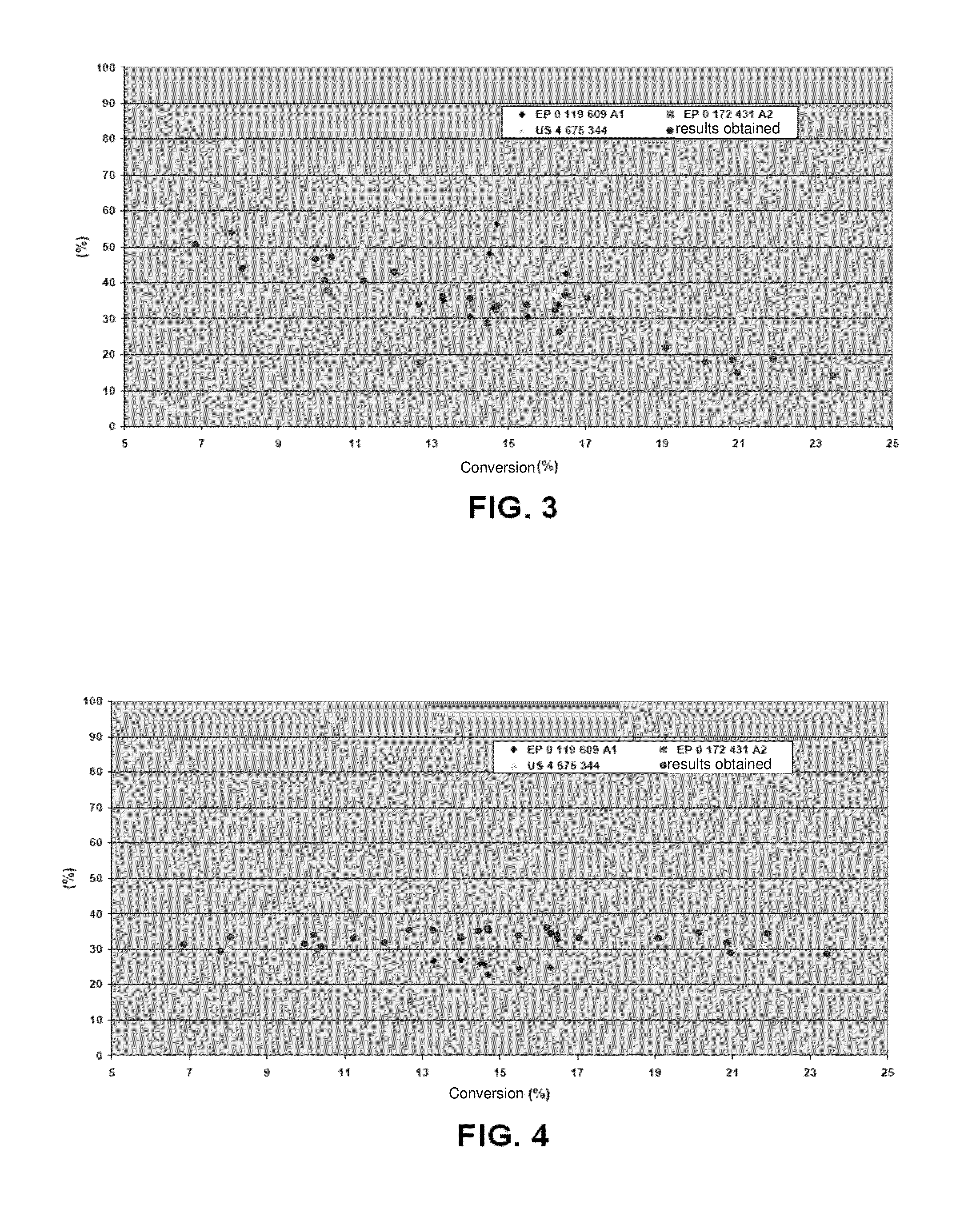Method for preparing catalysts for producing alcohols from synthesis gas
a technology of catalysts and synthesis gas, which is applied in the direction of catalyst activation/preparation, physical/chemical process catalysts, bulk chemical production, etc., can solve the problems of no commercial process, large equipment capital expenditure, and difficulty in synthesis gas to ethanol and higher alcohol, so as to achieve greater selectivity for ethanol and increase the ethanol/methanol ratio , the effect of increasing the selectivity
- Summary
- Abstract
- Description
- Claims
- Application Information
AI Technical Summary
Benefits of technology
Problems solved by technology
Method used
Image
Examples
example 1
[0059]This example illustrates the method of preparing a catalyst for processes of conversion of synthesis gas to ethanol and higher alcohols according to the present invention.
[0060]A vessel containing 100 ml of p-xylene is cooled in liquid nitrogen until the p-xylene solidifies. Next, the product is subjected to vacuum and is then heated until it returns to the liquid phase. This procedure is repeated twice and finally the vessel is filled with nitrogen.
[0061]An amount of approximately 1.25 g of sulphur is then added to the vessel containing p-xylene, under nitrogen atmosphere, with connection of a nitrogen supply and a reflux column.
[0062]The temperature of the mixture is increased until it reaches 140° C. for an interval of time of 30 minutes and is maintained at this value until all the sulphur has dissolved (approximately 10 minutes). Then the mixture is cooled to room temperature.
[0063]An amount of approximately 5.15 g of molybdenum hexacarbonyl, Mo(CO)6 is added and the temp...
example 2
[0067]This example illustrates tests for producing higher alcohols from synthesis gas using catalysts prepared as described in the present invention, where a stream of synthesis gas with H2 / CO ratio of between 1.0 and 2.0 and a content of H2S between 50 ppm and 100 ppm comes into contact with a catalyst bed at a temperature in the range from 260° C. to 340° C., a pressure of 50 bar and GHSV between 1000 and 5000 h−1.
[0068]The results obtained for a period of time of 200 hours for each test are shown in Tables 1 and 2 below.
[0069]Table 1 gives the results achieved in terms of productivity, or percentage mass flow rates of CO that are converted to higher alcohols (in this case, alcohols containing from 2 to 4 carbon atoms), ethanol and methanol.
TABLE 1Productivity ofConversion ofhigher alcoholsProductivity ofProductivity ofCO (%)(%)ethanol (%)methanol (%)0-250-7.30-5.10-4.6
[0070]Table 2 below presents the results, in terms of selectivity for ethanol, methanol and ratio of ethanol and ...
example 3
[0071]This example illustrates the textural properties of catalysts produced according to the method of the present invention.
[0072]Table 3 below illustrates the textural properties (average pore size, total pore volume and surface area) of catalysts produced according to the present invention.
[0073]The catalysts described in Table 3 below were prepared according to the method of the present invention, incorporation of alkaline promoter (K, Cs or Rb) having been carried out by physical mixing (identified as MF in the table) or wet impregnation (identified in the table as VU).
[0074]Moreover, for the catalysts in Table 3 below, their atomic ratios of alkaline promoter relative to molybdenum are shown, together with the percentage by weight of transition metal relative to the total weight of catalyst. In this case, the catalyst “0.1% Rh-0.3Rb / VU” in Table 3 refers to a catalyst with a percentage by weight of 0.1% of Rh, impregnated by the wet process, with an atomic ratio of 0.3 of Rb / ...
PUM
| Property | Measurement | Unit |
|---|---|---|
| temperature | aaaaa | aaaaa |
| temperature | aaaaa | aaaaa |
| temperature | aaaaa | aaaaa |
Abstract
Description
Claims
Application Information
 Login to View More
Login to View More - R&D
- Intellectual Property
- Life Sciences
- Materials
- Tech Scout
- Unparalleled Data Quality
- Higher Quality Content
- 60% Fewer Hallucinations
Browse by: Latest US Patents, China's latest patents, Technical Efficacy Thesaurus, Application Domain, Technology Topic, Popular Technical Reports.
© 2025 PatSnap. All rights reserved.Legal|Privacy policy|Modern Slavery Act Transparency Statement|Sitemap|About US| Contact US: help@patsnap.com



